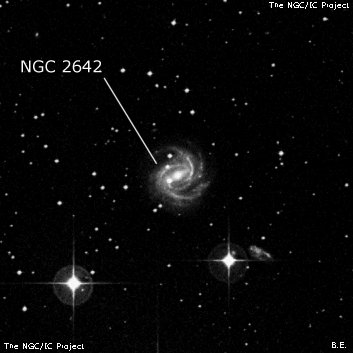
John Herschel discovered NGC 2642 = h519 on 19 Feb 1830 (sweep 234) and noted "A vF cl or r neb; gbM; 80", one * 17m distinct; stars and nebulosity; has 2 pB stars south and one following." Dreyer, observing on the 72" on 7 Mar 1877, recorded "Neby very distinct, though vF. I strongly suspect an eF branch foll the 4 [involved] stars, involving some vF stars." The "eF branch" probably refers to the southern spiral arm.
300/350mm - 13.1" (1/11/86): fairly faint, moderately large, almost round, diffuse, even surface brightness. Unusual appearance as a two mag 13/14 stars are superimposed at the north and SE ends of the halo. Three bright stars form an equilateral triangle just south; mag 8.9 SAO 136172 4.2' SE, mag 8.5 SAO 136168 6.0' S and mag 9.1 SAO 136160 2.8' SSW.
600/800mm - 24" (2/16/15): fairly bright, fairly large, dominated by an elongated bar oriented NW-SE with a mag 14 star superimposed at the southeast end of the bar. Two additional stars are superimposed nearly in a string to the north [mag 15 star 24" N and a mag 14 star 42" N]. Surrounding the bar is a low surface brightness glow encompassing these stars, perhaps 1.25' diameter. The spiral arms were not evident. Located just north of a bright, equilateral triangle of stars (mag 8.3/9.2/9.5) with sides ~4'.
Notes by Steve Gottlieb